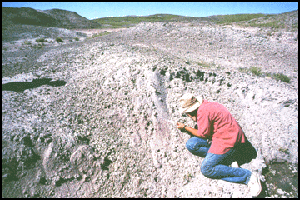Last updated: April 22, 2020
Article
Egg Mountain, the Two Medicine, and the Caring Mother Dinosaur
Article by John Dawson (2014 National Fossil Day Coordinator)
for 2014 Mesozoic Partner Highlights

Montana Geologic Road sign program

Photo from Wikimedia Commons (CC BY-SA 3.0).
These nests belonged to a dinosaur which has been named Maiasaura peeblesorum—the state fossil of Montana—which was discovered at Egg Mountain several months before the eggs themselves were found. Its genus name means "caring mother lizard." Since the time of this initial discovery, hundreds of specimens throughout all stages of life have been discovered, including eggs, juveniles, and adults. Maiasaura is in a family of dinosaurs known as hadrosaurs, a group of herbivorous dinosaurs often called "duck billed" dinosaurs. Hadrosaurs have been found throughout the world, and a great number have been found in North America. By studying the bones of Maiasaura it is has been determined that Maiasaura experienced a dramatic change in size as they aged. They would grow from their hatch size of less than 1 kg (2.2 pounds) to an adult size of 2,000 kg (~4,400 pounds) in a period of just 8 to 10 years. The discovery at Egg Mountain indicated that Maiasaura exhibited colonial nesting behavior, where large groups, likely herds, would all nest together in one area.
After hatching, the adults may have actively cared for their young for a significant amount of time. It has been suggested that Maiasaura seasonally migrated in order to meet the immense food needs of such a large group. Bone beds in the Two Medicine Formation have shown large groups of Maiasaura with individuals ranging from 3 meters (10 feet) to 7.5 meters (25 feet) in length. It is possible that Maiasaura would raise their offspring to the point that they could keep up with the herd, and then the herd would continue on their seasonal journey. It has also been suggested that Maiasaura behave in a way similar to modern sea turtles, returning to lay their eggs at the site that they themselves were born in.

Image © N. Tamura. (CC BY-NC-ND 3.0)

Photo by L. Psihoyos
